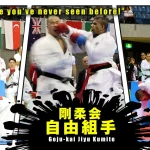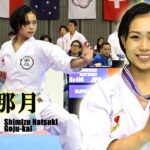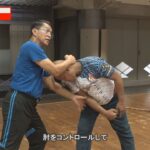William Reed’s Samurai Walk & Nanba Self-Protection
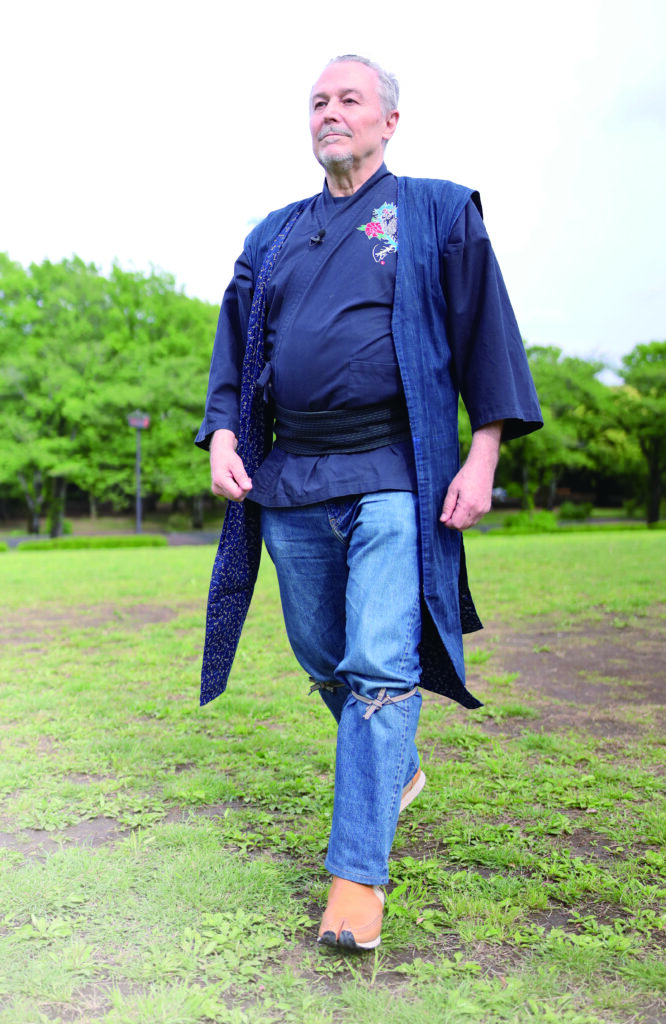 Move fast and easily without fatigue!
Move fast and easily without fatigue!
The Samurai Walk, developed from ancient Japanese martial arts
Willam Reed teaches the art of Nanba Walking
Reed-Style Nanba Walking is a contemporary adaptation of the Samurai walk derived from ancient Japanese martial arts (kobujutsu). It is a super-efficient walking method born out of traditional Japanese culture, which is completely different from modern walking that is based on Western physical education. In this Special Feature we introduce William Reed’s approach to Nanba Walking, based on his 50 years of exploration of Aikido and traditional Samurai Arts, as well as training in Nanba Jutsu.
Interview and text by Fumi Kato, editorial staff of Gekkan Hiden magazine
[FROM THE COVER OF JULY GEKKAN HIDEN]
Discover Japanese Lost Technology! What is the “modern utilization of kobujutsu” that can be applied in the present age?
HIDEN: Discover the secrets of Budo and Martial Arts
BUDO & KOBUJUTSU
William Reed’s Samurai Walk & Nanba Self-Protection
Use your body Standing, Walking, Running
Cultivate your strength and senses
Modern Utilization of KOBUJUTSU
Learning from the Samurai Walk in Tradition
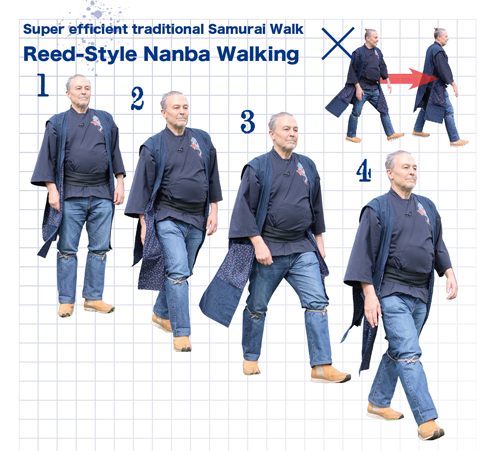
Start from the pelvis, as if pushed by the sacrum, do not kick off the ground, send the back foot forward and walk with a small step. Walk with a small stride, with the back foot sent forward, without kicking off the ground. The head should not move up and down. The hands should form a natural circular arc at the sides of the hip joints (①~④). Moreover, robot-like walking with arms and legs on the same side, as shown in the photo on the right, is not Nanba walking.
William Reed, Professor of Yamanashi Gakuin University, 10th-dan in Calligraphy, 8th-dan in Aikido, and 2-dan in Iaido, is a professor at Yamanashi Gakuin University, where he is currently teaching the Japanese arts and Samurai disciplines. He studied Nanba Jutsu with Yano Tatsuhiko, Chief Master of the Nanba Jutsu Association.
He teaches Nanba-walking which he learned from Yano Sensei, as part of traditional Japanese physical culture, and as a way of life. He also studied principles of physical movement from Nanba Master Yoshinori Kono’s son, Harunori Kono, and has combined this learning into a unique walking technique we call “Reed-Style Nanba Walking”.
This article outlines the principles and practical applications of his style and approach to Nanba walking.
Reed Sensei first encountered Nanba during Aikido practice, with his teacher Maruyama Koretoshi, founder of Aikido Yuishinkai. Described as “Samurai Walk” this had a strong appeal to his sensibilities, and he decided to research its roots. He discovered that a workshop called “Nanba Matsuri” had just been started by Yano Tatsuhiko, held monthly at Toho Gakuen, a leading Conservatory of Classical Music in Japan. He attended these workshops regularly over the next twenty years, and for four years also taught a course at Toho Gakuen in Nanba applied to Tap Dance. Yano Sensei and Reed Sensei often collaborate in the promotion of the art as well.
“The movement of Nanba was a natural fit for the Japanese kimono, obi belt, and straw sandals, so Nanba is also a good match for the Martial arts,” says Reed. In addition to applying Nanba in his daily life, Reed also practices Yuishinkai Aikido, and Hogyokukai Mugairyu Iaido. Reed said that he has found Nanba to be quite compatible with these arts.
He sees Nanba as one of the keys to improving the quality of your movement in all areas of life. Of course, there are essential movements that are unique to each art. However, he has also taught and practiced tap dancing with Nanba principles, and it has helped in the learning of Iaido.
It was very helpful to understand the elements of moving from the lower center, and increasing awareness and connectedness of movement in the bones and joints as practiced in Aikido.
Aikido and Budo practitioners are familiar with the words of the Founder of Aikido, Morihei Ueshiba, who said, “Walk and the Waza will appear.” (arukeba waza ni naru). Reed Sensei thought about this phrase through the practice of Budo, and realized that martial arts techniques do not react to an attack after it comes, but rather move synchronistically at the same time. Even when they start after, they arrive first (go no sen).
Reed gave as an example, the way that people see the attack and defense of Aikido. To the untrained eye, it may appear that the attacker (uke) is too slow, or somehow cooperating to allowing the other person (nage) to perform the technique in a form of cooperative dance.
To the trained practitioner, Aikido is a martial art in which the attacker seizes the beginning of the action and goes to lead and restrain the attacker. Reed believes that the reason the attacker looks slow is “because nage moves quickly and has space and time to catch the onset of the attack. You stand in a floating posture (itsukanai), so you have the capacity to meet the attacker’s attack by walking into the waza.”
Correcting balance by backward rotation: Reed-style Nanba walk
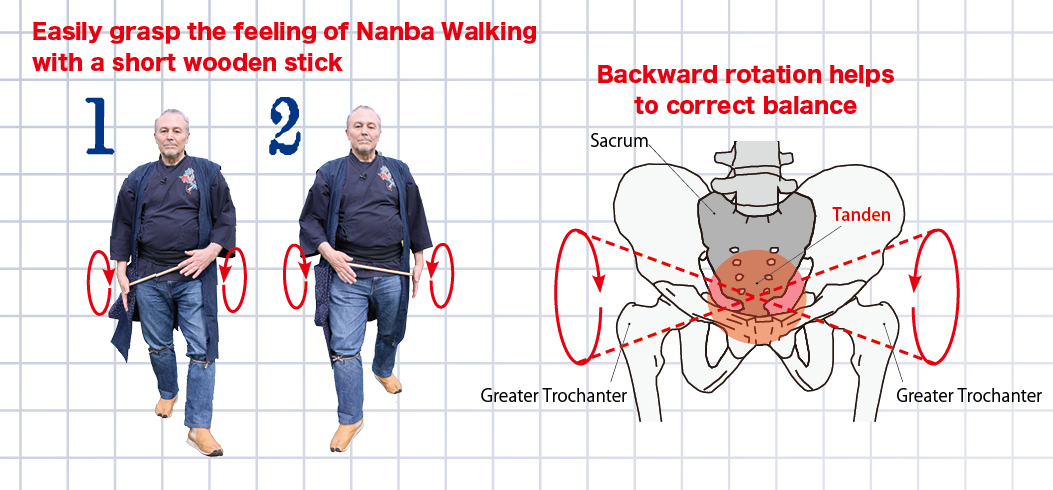
Hold both ends of the short stick between the palms and in front of the pelvis (tanden). As you begin to walk, in line with the movement of the Greater Trochanter at the side of your hip joint, the stick rotates backwards in a circle in a reverse direction to your forward movement. Coordinating the rotation of the stick with the step you take on each side helps you grasp the feeling of Nanba Walking. Correct posture can be maintained by coordinating the backward rotation of the hands in the upper limb movements with the movement of the legs as you step. The same effect can be achieved by moving your hands in a similar motion without the wooden stick.
The upper and lower body are organically integrated. The key to Nanba movement is to effectively connect the upper and lower body in movement. However, for a long time in modern society, each part of the body has been considered as separate parts. If you have been accustomed to a life in which each part of the body is isolated from the rest of the body, it is not easy think differently and acquire this skill.
Even if you practice Aikido or other martial arts, it is not easy to transfer this to how you walk in daily life. It is rare to receive detailed instruction on how to walk in everyday life. Moreover, Nanba Walking is often misunderstood as simply walking with your arms and legs moving together on the same side. This robotic movement is not Nanba Walking.
However, with the use of just a few small tools it becomes easier to master the Nanba Walk. One such tool is a short stick about 40 centimeters long, and the width of your forefinger. Reed Sensei learned this technique from Hasegawa Satoshi, a Shugendo Master or Mountain Monk, well known through his articles in Gekkan Hidden and Budo Japan.
For the short stick Nanba technique, hold both ends of the stick between your palms in front of your pelvis (tanden) before you start walking. As you start walking move the stick between the two hands in coordination with the movement of your steps. The wooden stick rotates in the reverse direction between the two hands as the legs move forward. As shown in the illustration, the hands draw a small circle at the side of the greater trochanter at the hip joint.
Human beings walk on two legs, and as we move forward, we tend to lean forward. This is unbalanced, and places a heavy burden on the knees.
The posture can be corrected by making a small backward rotation with the hands at the level of the hips. Torque is generated in the rotation of the bones, and the feeling of Nanba Walking is close to the rolling of a wheel smoothly on the surface of the ground. This is also the movement that links the upper and lower parts of the body.
In Yano Sensei’s Toho Gakuen style of Nanba walking basically you move your hands up and down to coordinate upper and lower parts of the body with your steps.
Reed Sensei makes use of the short stick to illustrate the reverse circular motion, and this can also be done without holding a stick. The hand draws a natural arc at the side of the hip joint. With practice, this movement can be made just with the fingertips.
In contrast to modern walkers who twist and swing their arms and kick off the ground with their feet, in Nanba Walking the start of the movement is from the pelvis, particularly the sacrum, and there is no up and down movement of the head. If you practice it, you will find Nanba Walking will feel more comfortable than modern style walking.
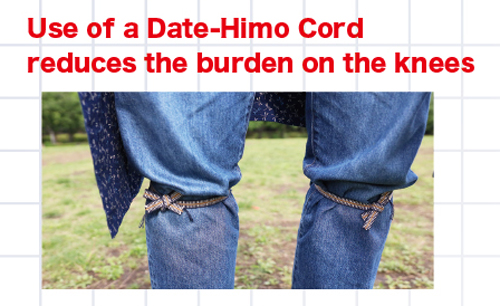
Tie the date-himo cord under the knee cap, secure but not too tight. This will lightly brace the movement of the knee, preventing the body from leaning forward, and reducing the burden on the knees.
According to Reed, the origin of the word Nanba is 難場 or difficult place. In the medieval and early modern periods, when the transportation network was not developed, travel was often through mountainous areas. Japan is mostly mountainous, so people had to face long-distance travel over hilly terrain, and they developed ways of walking that would make it easier to walk under such circumstances.
A particular application of the Date-Himo Cord resulted from the wisdom of these people. It is tied under the knee cap, firm but not too tight. This acts a a brace, providing a light restriction on the knee movement, preventing the body from leaning forward. It has similar effects as Nanba walking with a short stick, preventing imbalance, fatigue, and knee pain. This is a Ninjutsu technique which Reed Sensei learned from Ninja Master Narashino Ryukyu.
Beware of walking while looking at your cell phone!
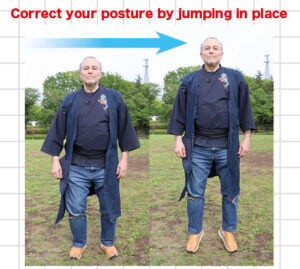
Just a few light jumps in place will naturally correct your posture, so that the legs are naturally positioned under the shoulders and pelvis. This helps you to stand comfortably.
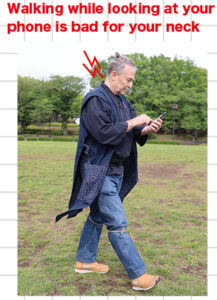
The human head weighs about five kilograms, yet when tilted forward 60 degrees as in looking at a smartphone, the effective burden on the neck is about 27 kilograms.
It is not uncommon to see people walking while looking at their phones. A human head has a weight of about five kilograms when standing straight in good posture. However, if a person’s head is tilted forward 60 degrees, then the burden on the neck becomes about 27 kilograms. It is also a burden on the body. Walking like this while looking at your cell phone can cause headaches, neck pain, and stiff shoulders.
Even if you don’t walk looking at your phone, if your life is centered around desk work, you may develop the same problem.
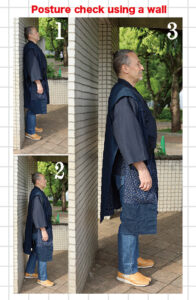
Stand with the back of the head, shoulder blades, and sacrum against the wall ①. From here, take a half step forward ②, stepping into a comfortable, arched posture like a well-strung Japanese bow ③.
The easiest way to correct your posture is to jump lightly in place. After a few times your feet will naturally settle under the shoulders and pelvis, creating a comfortable standing posture.
Reed says, “If you have a wall close by, you can use it to correct your posture. Put the back of the head, shoulder blades, and sacrum on the wall. The posture is literally straight, but it may feel uncomfortable, as if you are literally up against the wall. The human spine has an S-curve centered in the vertebrae that does not conform to the geometric vertical direction. However, if you take a half-step forward from this point, the body naturally arches into a comfortable posture.”
This is the same as the posture in Nanba Walking, which is easy and also has the advantage of providing a wide field of vision.
There are no masters who walk with a big stride
One of Reed Sensei’s favorite Japanese proverbs is, “There are no masters who walk with a big stride “(ohmata ni meijin nashi).
Walking with a small stride is one of the characteristics of the Nanba Walk. People sometimes object, “Isn’t it too slow to walk with small steps?”
We tested walking side by side comparing modern walking which takes a large stride with Nanba Walking in a shorter stride, and found that Nanba Walking is actually faster than the modern walk, perhaps because of its efficiency. Modern walking looks dynamic, but the body twists and turns, there is a lot of unnecessary movement and loss of power. Force is lost due to unnecessary movement and kicking off the ground.
Western-style military training was introduced from the end of the Edo period to the Meiji period (1868-1912), and Samurai struggled to learn Western (modern) movements such as military marching.
The Hidden Blade (Kakushi Ken Oni no Tsume) is a movie directed by Yamada Yoji. This and various other films show this struggle. In exchange for what they gained from Western culture, they also lost a great deal.
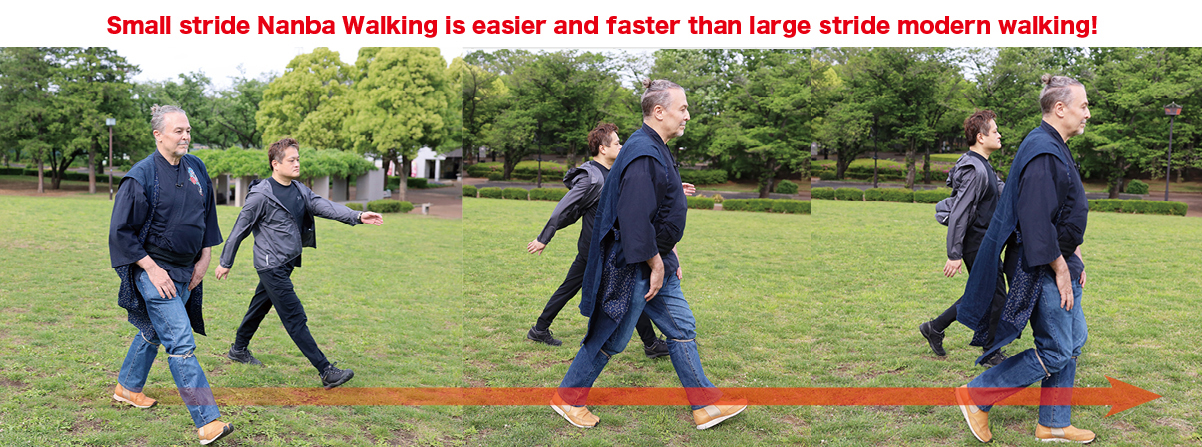
Starting at the same time and walking side by side, we found the small stride of Nanba Walking was faster than modern walking, which takes a large stride. Moreover, it is less stressful on the body and less tiring.
The Non-Abiding Dragonfly as the Victory Insect of the Samurai
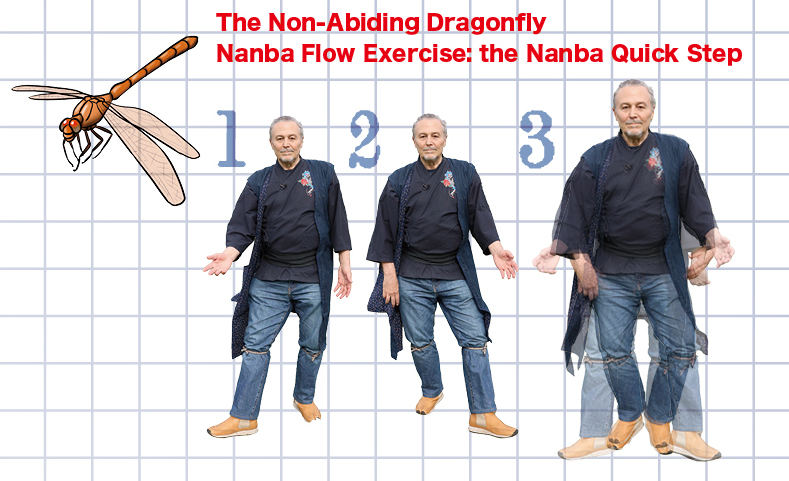
The dragonfly was considered by the Samurai to be the Victory Insect. Here, as in the Cossack Dance, the right foot ① is alternated with the left foot ②. The Nanba Quick Step puts the body in a state of vibration ③, so it moves quickly like a dragonfly without settling.
Nanba Walking was derived from the Samurai Way of Walking and body movement. Dragonflies were often considered by the Samurai to be Symbols of Victory, decorating helmets, armor, and clothing.
Why was the Dragonfly such a celebrated symbol? The standard answer you often hear is, “because they only move forward.” However, dragonflies actually move at high speeds, stay in the air for an instant, change directions, and can even cut through the air to capture their prey. Masters of airborne navigation, the wings of the Dragonfly are highly mobile and flexible. Its wings are always turning around at different angles at a dizzying pace during its flight. This mastery of stillness and movement says Reed, is the reason dragonflies were celebrated by the Samurai.
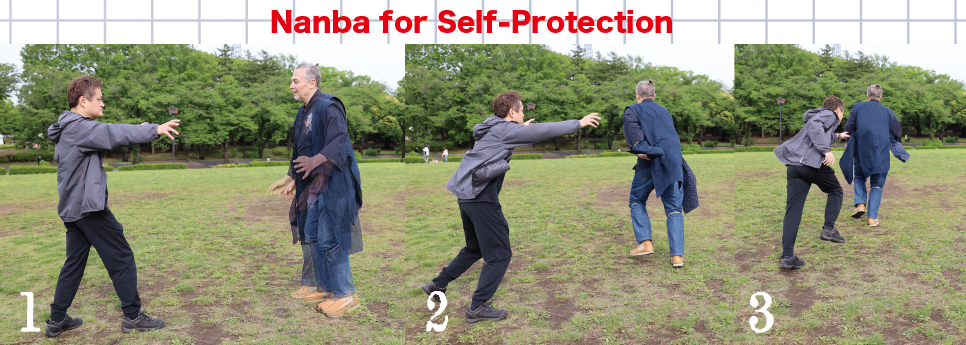
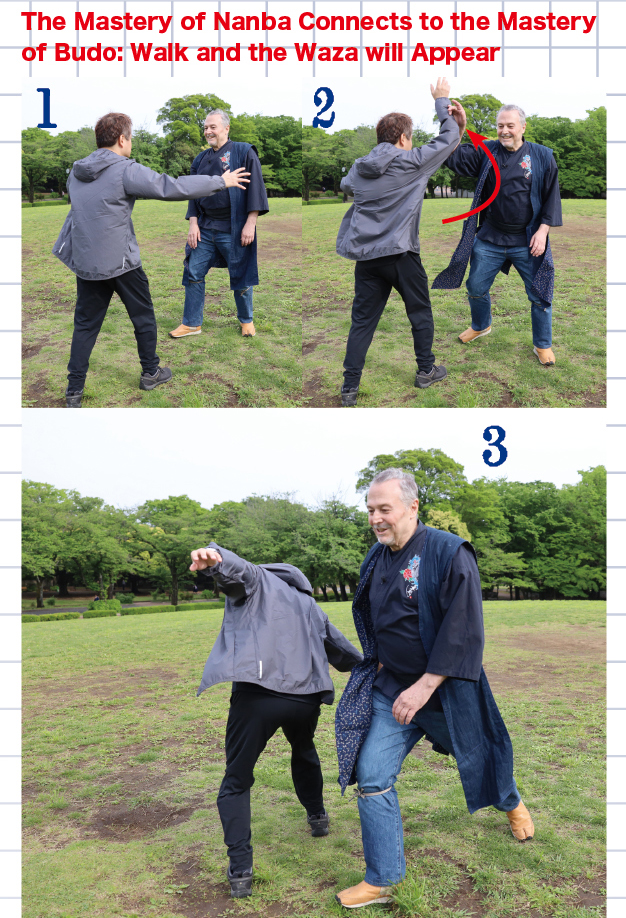
As above, when blocked from the front, use the Nanba movement of the hand by turning your right hand in the opposite direction of the hand movement of walking ①②, and continue walking forward as you are. You can easily deflect the opponent’s arm and keep walking ③. This is an application of what Ueshiba Morihei said, “Walk and the Waza will appear.”
Humans cannot fly in this way, but we can emulate this movement by moving the entire body from the upper limbs to the lower limbs, and move without abiding on the surface of the ground.
One of the exercises in Nanba Flow Movements is the Nanba Quick Step (sasatto step), which causes the whole body to vibrate like a dragonfly. This makes it difficult to predict the next movement, and enables you to move quickly in any direction. Self-Protection is a “difficult situation” that can be handled by picking up hints from the dragonfly. Reed Sensei teaches this technique to female university students as part of Nanba Self-Protection Techniques.
Simulating a situation where a person was blocked on the street by a drunk or surrounded by several people, Reed asked several male students to play the role of his opponents, and demonstrated a quick step escape. A female student then tried it, and none of the male students were able to catch up with her.
The movement of Nanba, which like the dragonfly does not settle down, is naturally contained in Nanba walking. This is also a good way to avoid danger in the event of a traffic accident or other emergency. If you learn to walk with Nanba, you will be able to walk with ease. It is also useful for self-Protection and health, and will greatly improve the quality of your daily life.
If we use Nanba in all of our movements in our daily life on a regular basis, we can approach the spirit of the motto of Gozo Shioda, the Master of the art of Aikido who said that “Whenever you go, live, sit, or lie down, this is the best place to be, this is your Dojo.”
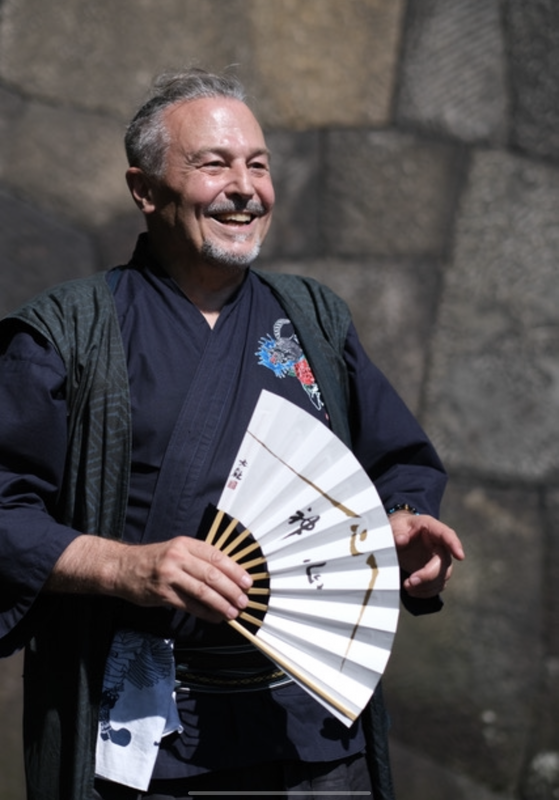 William Reed
William Reed
Born in the United States, William Reed is a long-time resident of Japan, and is currently a Professor of Japanese Culture at the International College of Liberal Arts (iCLA) at Yamanashi Gakuin University. He holds a 10th-dan in Shodo from the Zen Nihon Shodo Rengokai, and is a Headquarters appointed Vice Chairman of the Japan Calligraphy Education Association. He holds an 8th-dan in Aikido from the Aikido Yuishinkai. He is a Certified Graphology Adviser from the Japan Graphologist Association. He holds a Tokubetsu Shihan rank in Nanba, the Art of Physical Finesse. Director of the International Committee for the Mugairyu Hogyokukai, Director of Yamanashi Prefecture Hogyokukai (2nd-dan). A regular commentator on Yamanashi Broadcast Television Tetete TV, Navigator for NHK World Journeys in Japan, numerous documentaries, and has appeared on the long running Sekai Fushigi Hakken (Discover the World’s Mysteries). Certified in 2009 by World Champion of Public Speaking Craig Valentine, he has written a bestseller on this in Japanese 世界最高のプレゼン術 (Kadokawa Books, 2014). He is also author of Song of the Brush Dance of the Ink (Morgan James Publishing, 2022). He appears in the bestselling DVD on Nanba Walking 本当のナンバ歩き, and the DVD on Introduction to Mugairyu Iaido, both published by BAB Japan.
Samurai Walk: Mastery of Sword and Letters:
http://www.samurai-walk.com






